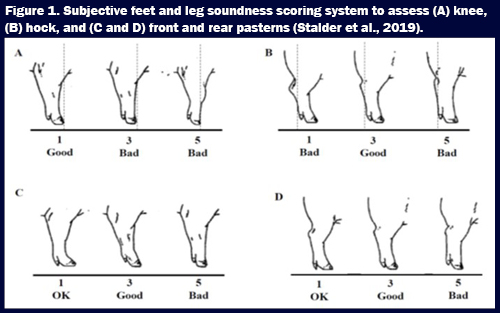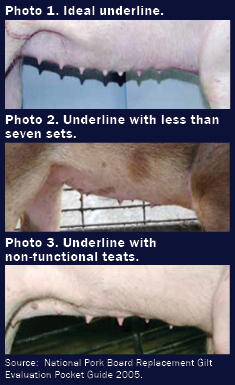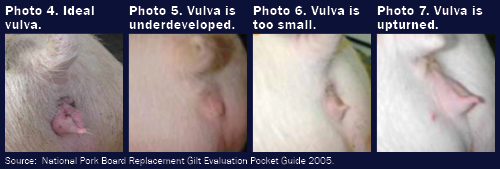
Sow management: Proper gilt selection criteria
 By Jaron Lewton
By Jaron LewtonWhether you buy gilts to bring into the herd or have an internal breeding program, there are several things to consider when developing a selection checklist.
1. Gait
Good replacement gilts should stand and walk with even, forward-pointing toes. They should have a flat, strong topline without any arches or dips in the back.
2. Feet and legs
Front legs should be straight and rest directly under the shoulders (A). Back legs should lie slightly ahead of the hock (B). On both front and rear feet, pasterns should set at a 45-degree angle to the ground (C and D); anything well below or above this is problematic (Stalder et al. 2019).

3. Underline
Select those with at least seven sets (14 total) of evenly sized and spaced teats (photo 1). Avoid those with less than seven sets (photo 2) or an underline with multiple undeveloped or non-functional teats (photo 3).
4. Vulva
Avoid gilts with relatively small or upturned vulvas as these are associated with farrowing problems. Photos 5-7 are examples of non-ideal vulvas. Vulva width also relates to lifetime performance – the wider the better. Aim for selecting gilts with a vulva width greater than 1.3 inches at 105 days of age (Rosomer et al. 2020).

About the author: Jaron Lewton is a Vita Plus swine technical sales specialist. He was raised on his family’s hobby farm in LaGrange, Indiana, and attended Huntington University to receive his bachelor’s degree in agribusiness. During this time, he gained experience in animal husbandry as a farm hand in Laos, as well as greater knowledge of the feed industry through an internship with an egg production farm, where he specialized in nutrition and feed manufacturing. Lewton then joined a management team of a 1,500-sow operation in northern Indiana before attending Michigan State University to receive his master’s degree in swine nutrition. His thesis focused on utilizing feed additives in nursery pig diets.
| Category: |
Reproduction and genetics Swine Performance |

